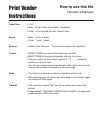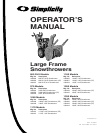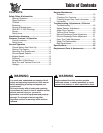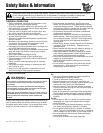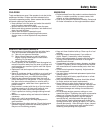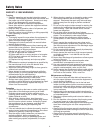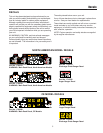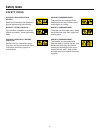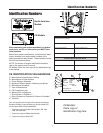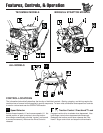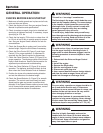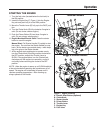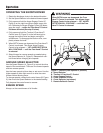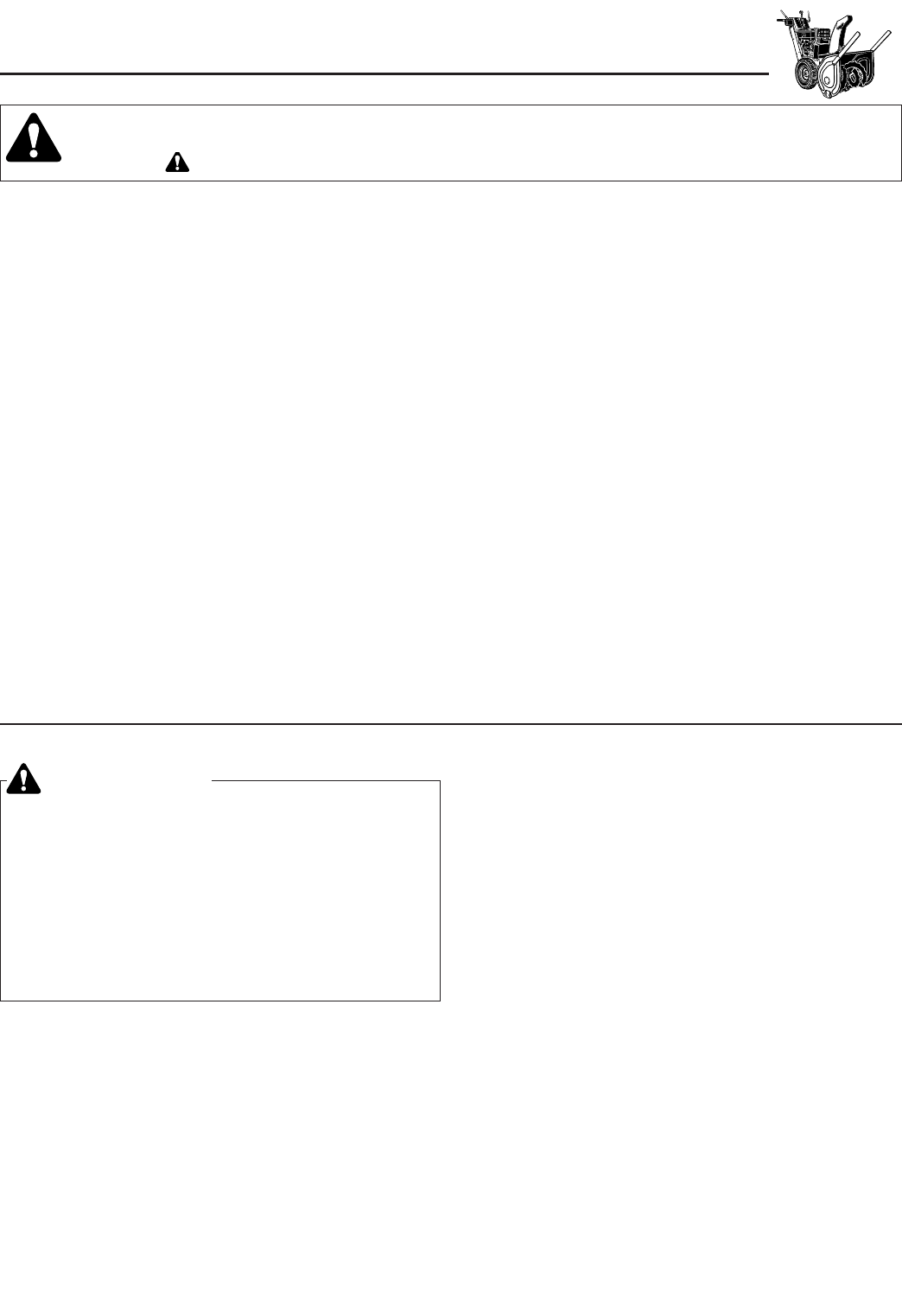
2
Safety Rules & Information
GENERAL OPERATION
• Read, understand, and follow all instructions in the
manual and on the unit before starting.
• Only allow responsible adults, who are familiar with
the instructions, to operate the unit (local regulations
can restrict operator age).
• Clear the area of objects such as rocks, toys, wire,
etc., which could be picked up and thrown.
• Be sure the area is clear of other people. Stop unit if
anyone enters the area.
• Always look down and behind before and while trav-
elling in reverse.
• Be aware of the discharge direction and do not point
it at anyone. Do not point the discharge at glass
enclosures, automobiles, or windows.
• Disengage all clutches (release drive and auger con-
trol levers) before starting the engine.
• Never leave a running unit unattended. Always disen-
gage the auger and traction controls, stop engine,
and remove keys.
• Stop engine before unclogging chute.
• Operate only in daylight or good artificial light.
• Do not operate the unit while under the influence of
alcohol or drugs.
• Watch for traffic when operating near or crossing
roadways.
• Use extra care when loading or unloading the unit
into a trailer or truck.
• Keep in mind the operator is responsible for acci-
dents occurring to other people or property.
Read these safety rules and follow them closely. Failure to obey these rules could result in loss of control
of unit, severe personal injury or death to you, or bystanders, or damage to property or equipment.
The triangle in text signifies important cautions or warnings which must be followed.
SLOPE OPERATION
Slopes are a major factor related to loss-of-control and tip-
over accidents, which can result in severe injury or death.
All slopes require extra caution. If you cannot back up the
slope or if you feel uneasy on it, do not operate on it.
Do
• See your authorized dealer for recommendations
counterweights to improve stability.
• Travel up and down slopes, not across.
• Remove obstacles such as rocks, tree limbs, etc.
• Watch for holes, ruts, or bumps. Uneven terrain could
overturn the unit. Snow can hide obstacles.
• Use slow speed. Tires may lose traction on slopes.
Choose a low gear so that you will not have to stop or
shift while on the slope.
• Keep all movement on the slopes slow and gradual.
Do not make sudden changes in speed or direction.
• Always keep unit in gear especially when traveling
downhill.
Do Not
• Do not start or stop on a slope. If tires lose traction,
disengage the auger and proceed slowly straight
down the slope.
• Do not turn on slopes unless necessary, and then,
turn slowly and gradually downhill, if possible.
• Do not operate near drop-offs, ditches, or embank-
ments. The unit could suddenly turn over if a wheel is
over the edge of a cliff or ditch, or if an edge caves in.
• Do not operate on wet surfaces. Reduced traction
could cause sliding.
• Do not shift to neutral and coast down hills.
WARNING
Never operate on slopes greater than 17.6 percent (10°) which
is a rise of 3-1/2 feet (106 cm) vertically in 20 feet (607 cm)
horizontally.
When operating on slopes use additional wheel weights or
counterweights. See your dealer to determine which weights
are available and appropriate for your unit.
Select slow ground speed before driving onto slope. Travel UP
and DOWN the slope, never across the face, use caution when
changing directions and DO NOT START OR STOP ON
SLOPE.
• Data indicates that operators, age 60 years and
above, are involved in a large percentage of power
equipment-related injuries. These operators should
evaluate their ability to operate the unit safely enough
to protect themselves and others from injury.
• All operators should seek and obtain professional
and practical instruction.
• Always wear substantial footwear and appropriate
winter clothing. Wear foot-ware that improves trac-
tion on slippery slopes. DO NOT wear long scarves
or loose clothing that could become entangled in
moving parts.
• Before using, always visually check that all hardware
is present, in-tact, and secure. Replace worn or
damaged parts.
• Never operate the machine with defective guards, or
without safety protective devises in place.
• Stop engine before: refuelling, removing an attach-
ment, making adjustments (unless the adjustment
can be made from the operator’s position).
• Follow the manufacturer’s recommendation for wheel
weights or counterweights.
• Adjust skid shoe height to clear gravel or crushed
rock surfaces.
• Do not touch snowthrower parts which may be hot
from operation. Allow such parts to cool before
attempting to service the unit.
TP-600-3606-00-LW-UV



